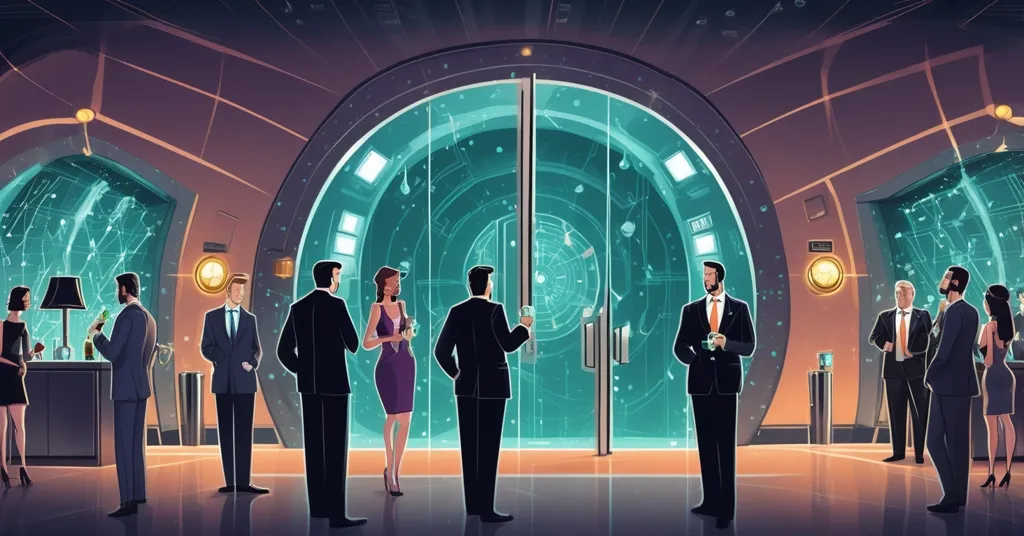U.S. Banks Cut Credit Card Approvals by 5% in 2025: Is DeFi the Answer?

U.S. Banks Slash Credit Card Approvals by 5% in Q2 2025: A Push for DeFi?
Major U.S. banks have pulled back sharply on new credit card approvals, posting a 5% decline in Q2 of 2025 during Donald Trump’s first full year back in power. Heavyweights like JPMorgan Chase, Citigroup, Capital One, and American Express are tightening the screws on lending, favoring the wealthy elite while leaving everyday Americans scrambling for options in an already strained economy.
- 5% drop in new credit card accounts in Q2 2025, the first decline in over a year.
- Banks shift focus to high-income clients with luxury perks and premium cards.
- Lower-income households face rising debt and exclusion from credit access.
Banking’s Elite Shift
The data paints a grim picture for anyone not in the top income bracket. According to the Federal Reserve’s Senior Loan Officer Survey, major banks have jacked up approval requirements, especially for those deemed higher-risk—typically folks with FICO credit scores below 640, a common benchmark for measuring creditworthiness. Think of a credit score as your financial report card; below 640 often means you’re seen as a gamble for lenders, more likely to miss payments. This isn’t a subtle tweak—it’s a full 5% reduction in new accounts compared to last year, the first such drop in over 12 months. Instead of broadening access, banks are doubling down on the affluent, offering premium products that ooze exclusivity, from high-end cards with hefty fees to luxury experiences tailored for the 1%.
Capital One is a prime example, unveiling their Venture X lounge at JFK Airport for cardholders willing to fork over a $395 annual fee just for the privilege of sipping cocktails in style. Their CEO, Richard Fairbank, didn’t shy away from the strategy behind it:
“The highest, fastest-growing part of the company’s card business has come from ‘heavier spenders.’”
Translation? They’re chasing big wallets, not broad access. American Express is playing the same game, with new account openings down 6% year-over-year, yet their average annual fee per card climbed from $101 to $117 as premium products like the Platinum card—some tiers nearing $1,000—gain traction. Their customers are splurging too, with spending on first-class airline seats up 10% and short-term rentals over $5,000 rising 9%. This isn’t just a trend; it’s a deliberate pivot to a clientele that doesn’t flinch at five-figure vacation tabs.
Marketing efforts underscore this elitism. Over 87% of credit card mail in April 2025 was prescreened, targeting consumers with FICO scores of 720 or higher—essentially the “excellent” credit crowd. That’s the highest share since 2022, according to Megan Cipperly, Vice President at Competiscan:
“Only a small subset of consumers are receiving the lion’s share of credit-card offers, and they’re not necessarily the ones who need more credit.”
If your score doesn’t sparkle, you’re basically invisible to banks like JPMorgan and Citigroup, who are curating their customer base with surgical precision, as seen in recent reports on lending cutbacks.
The Cost for Everyday Americans
While the wealthy enjoy bespoke perks, the rest of America is getting hammered. Card balances among non-wealthy households are ballooning, with average credit card interest rates hitting a punishing 24.35%, per LendingTree data. To break that down, interest is the cost of borrowing money on unpaid balances, often compounding monthly. Imagine a snowball rolling downhill—start with a $1,000 debt, and at 24.35%, that can swell fast if you’re just paying the minimum. It’s a brutal burden for lower-income families already struggling, made worse by shrinking access to new credit lines when they need a lifeline most. The impact of denied applications only adds to their financial stress. Sure, delinquency rates—payments missed for 90 days or more—have held steady, but that’s cold comfort when you’re drowning in debt with no way out.
Here’s the kicker: not all the numbers add up cleanly. While the 5% approval drop is widely reported, some industry whispers suggest application volumes are actually at record highs. Are banks just being pickier rather than outright shutting doors? Possibly, but the impact hits hardest for those already on the financial edge. And get this—there are hints of rising defaults even in high-income areas, which seems odd given banks’ obsession with “safe” clients. Could the elite be over-leveraging on those shiny premium cards? We need raw data from Q2 2025 bank reports or Federal Reserve reports to cut through the noise. No half-baked stats here—just facts, or we’re not buying it.
Trump’s Economic Shadow
This all unfolds under Donald Trump’s return to the White House, with the U.S. economy showing grit but not without cracks. JPMorgan CEO Jamie Dimon summed it up:
“The U.S. economy remained resilient in the quarter… [but] significant risks persist.”
What risks? Could be anything from inflation creeping back to global tensions rattling markets—specifics are scarce, but the unease is palpable. Banks are playing it safe, or maybe just greedy, opting for conservative lending over inclusion. Trump’s past term leaned hard on deregulation and pro-business policies, and if 2025 is a rerun, it might give banks even more room to prioritize profits over people, as discussed in analyses of his economic influence. Think fewer consumer protections, less oversight from agencies like the Consumer Financial Protection Bureau, and more leeway for exclusionary tactics.
But let’s not pin it all on politics. This mirrors historical cycles—banks tightened up post-2008 and during the 2020 pandemic chaos when uncertainty loomed. Today’s caution isn’t new; it’s just dressed up with luxury lounges and platinum perks. Still, if deregulation emboldens banks to double down on the elite, expect public backlash—or a quiet migration to alternatives that don’t bow to boardroom priorities, as some online discussions are already highlighting.
DeFi: A Disruptive Answer?
For those of us rooting for decentralization, this banking trend is a glaring neon sign. When traditional finance builds walls, it’s time for blockchain to build bridges. Could credit card exclusion in 2025 fuel decentralized finance growth? DeFi—short for decentralized finance—offers lending and borrowing through blockchain protocols, no bank middleman required. Picture this: you deposit crypto like Bitcoin or Ethereum as collateral, borrow stablecoins (digital assets pegged to fiat like the U.S. dollar), and sidestep credit scores entirely. Platforms like Aave or Compound already facilitate this, letting anyone with digital assets access loans, provided they over-collateralize—meaning you lock up more value than you borrow to cushion against price swings. This potential is explored in recent insights on DeFi’s role as an alternative.
Here’s the rub: DeFi isn’t a flawless fix. Smart contracts—self-executing agreements coded on blockchains like Ethereum—can have bugs, leaving funds vulnerable to hacks. And if your collateral (say, Bitcoin) tanks in value, you risk liquidation, losing your assets to cover the loan. It’s a wild west compared to a bank’s stodgy paperwork, but it’s also freedom. Bitcoin doesn’t care about your FICO score; it’s money for everyone, not just the elite. Even altcoins like Ethereum power DeFi’s gears, filling niches Bitcoin might not touch, like complex lending protocols. This isn’t just rebellion—it’s effective accelerationism in finance, speeding up tech-driven solutions to dismantle outdated gatekeeping.
Banks chasing the 1% might just push more folks toward crypto lending solutions. Why beg for a card with 24.35% interest when you can collateralize your holdings and borrow on your terms? Sure, the risks are real—volatility can wipe you out if markets crash—but at least you’re not at the mercy of a prescreened mailer. For Bitcoin maximalists, this is a rallying cry: traditional finance is failing the masses, and decentralized systems are the raw, messy, but open alternative we’ve been waiting for, especially under current economic policies.
What’s Next for Financial Freedom?
The financial landscape in 2025 is a stark divide—one side sipping martinis in airport lounges, the other refreshing “application denied” emails under crushing debt. Banks are betting on the affluent while lower-income Americans bear the brunt of exclusion and high interest. Under Trump’s economic shadow, with resilience tainted by risks, this trend could deepen inequality—or spark a revolt against gatekeepers. For crypto advocates, it’s both a warning and a window. Blockchain credit alternatives aren’t perfect, but they’re a middle finger to systems prioritizing fees over freedom. If banks won’t serve the masses, let’s keep hammering at solutions that do. Decentralization isn’t just a buzzword; it’s the future we need to fight for.
Key Takeaways and Questions
- What’s driving the 5% drop in credit card approvals in 2025?
Banks are tightening lending standards to dodge risk, sidelining lower-income and higher-risk applicants while prioritizing wealthy clients for safer, bigger profits. - How are banks reshaping their focus under Trump’s administration?
They’re targeting high-income customers with premium cards and luxury perks like Capital One’s JFK lounge, using prescreened marketing to court top credit scorers. - What’s the impact on everyday Americans?
Lower-income households are shut out of credit, burdened by rising balances and 24.35% interest rates, deepening financial stress despite steady delinquency numbers. - Could banking exclusion boost decentralized finance growth?
Absolutely—restricted traditional credit may drive interest in DeFi and crypto lending, offering bank-free alternatives, though with risks like volatility and smart contract flaws. - Are there hidden dangers in the economic resilience banks rely on?
Yes, as Jamie Dimon warns of persistent risks despite a strong economy, hinting that banks’ caution could falter if inflation or global issues disrupt stability.



